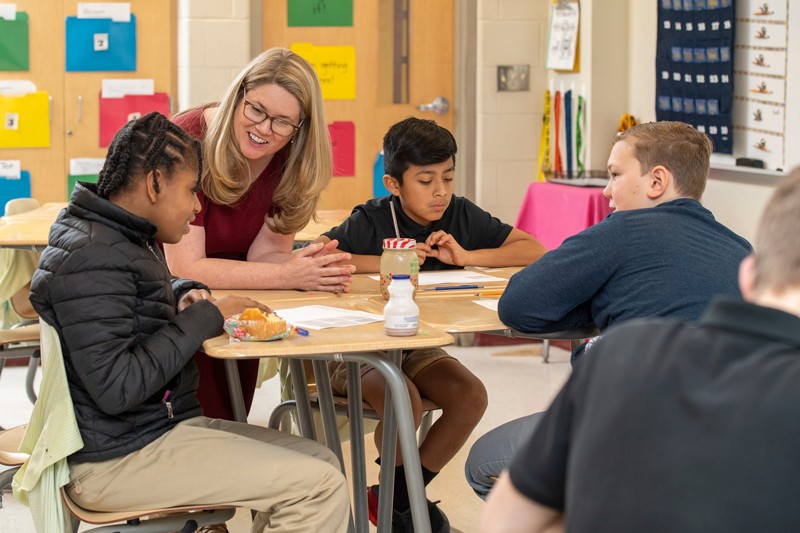School of Education
Rough Draft Math

There’s a better way for students to learn math, says UD professor Amanda Jansen
Do you remember what it was like to learn math? How challenging it was to find solutions to problems that you didn’t understand? The dread of wrong answers?
Before joining the University of Delaware’s School of Education, Professor Amanda Jansen was a junior high mathematics teacher, and she had these conversations with students all the time. Math should prompt interesting questions, she says, but when students constantly feel pressured to get the “correct” answer, it becomes difficult to view perplexity as a valuable part of the learning experience—as the kind of creative thinking that makes math interesting.
“Most of us have experienced mathematics classrooms where the ‘smart’ students were those who arrived at the correct answers quickly,” Jansen wrote in her new book, Rough Draft Math: Revising to Learn. “Everyone wants to feel smart, and no one wants to feel embarrassed for being wrong.”

Rather than having students internalize that feeling of uncertainty, Jansen argues for a new kind of mathematics instructional approach that emphasizes problem solving as an iterative process, similar to using rough drafts in language arts classrooms.
“Rough draft thinking happens when students share their unfinished, in-progress ideas and remain open to revising those ideas,” Jansen said. In contrast to “final draft” talk, which is presentational and performative, “rough draft” talk is exploratory and uncertain, encouraging students to follow their intellectual curiosity, to take risks and revise their ideas even if they got the “correct” answer on the first try.
What is Rough Draft Thinking?
When it comes to rough draft thinking, answers matter less than process. Sharing unfinished “drafts” and revising emerging ideas provide opportunities for students to change their approach to solving a problem or explaining a solution.

“Learning is messy business. When we learn, we actively work to make sense of an idea that does not make sense to us yet,” said Jansen, who began the research for Rough Draft Math in 2016 during a state-wide study group for middle and high school math teachers in Delaware. From there, the project snowballed, ultimately collecting data from 18 teachers in 16 schools, including 15 teachers in Delaware.
“As more teachers learned about the ideas, more teachers invited me into their classrooms or contacted me to share how they used rough drafts in their classroom,” Jansen said.
One of those teachers is Brandy Cooper, who teaches sixth-grade math at Milford Central Academy and co-wrote the article “Rough-Draft Talk in Mathematics Classrooms” with Jansen and Delaware middle school teachers Stefanie Vascellaro and Philip Wandless, published in Mathematics Teaching in the Middle School in 2016. The goal of rough draft thinking, Cooper said, is for students to feel comfortable sharing their unfinished ideas.
“When a student shares an answer, we take time to think through it together,” says Cooper. “I feel this creates a more curious culture in my classroom.”
Revision in Mathematics
“Revising in math class is not fixing an error. It’s way more than that,” says Jansen. Even when the correct answer is already apparent, revision challenges students to make their explanations more precise, or include more mathematical terminology, or represent the solution differently using diagrams or drawings.
This is how students are learning math in Cooper’s classroom. After some warm-up exercises, Cooper and her class get to work solving simple equations. As she moves around the classroom, Cooper asks students, “What are you thinking about? Is there just one way to solve this problem? Or are there many? See how many equations you can come up with.”

Each group then explains their thinking and shares one or more solutions via the classroom Smart Board. Although the answers are nearly all correct, the process encourages students to get creative with their problem solving. By asking students to explain their thinking, and then responding with a sense of understanding at how students arrived at the answer, teachers can create a space for productive classroom conversations where students feel confident sharing unfinished ideas.
“My students are more open to taking risks,” says Cooper, adding that these exercises also build confidence among her students. “It creates a whole different culture in your classroom when you shift the focus like that.”
Jansen and her colleagues received recognition from the National Council of Teachers of Mathematics for their collaborative work on rough draft math in 2018. Jansen’s highly anticipated book, Rough Draft Math: Revising to Learn, is now available through Stenhouse Publishers.
Article by Jordan Howell
Photos by Kathy F. Atkinson



